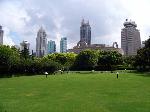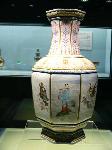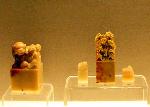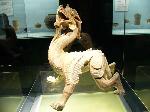- Getting around Lijiang. Dont stay in the Old Towns more than 2 days, there is nothing to do. KRISS Oct 9, 2013 05:46
- 2013 Beijing Temple Fair BENNYLAU Feb 26, 2013 03:29
- Malaysian traveling from KUL - LAX vis Shanghai PVG ZATI_DY Jan 3, 2013 20:15
If Art is Your Passion
- Views: 3968
- |Vote: 0 0
- |Add to Favorites
- |Recommend to Friends
The People’s Park
You’d be quite mistaken to assume that Shanghai’s Renmin Square, otherwise known as the People’s Park, is just your average strolling area for city slickers. Often compared with New York’s Central Park, this thirty acres of luxurious, verdant grass, lotus ponds, flower beds and walkways is a literal breath of fresh air in the midst of Shanghai’s metropolitan hub. It’s right next to the famous – and exhausting – Nanjing Road, where shoppers from around the world convene to descend upon Shanghai’s boutiques and restaurants, and also not far away from many of the city’s popular nightclubs – meaning that if you stop by at around midnight you’ll see crowds of well-dressed, attractive Shanghainese cooling off in the open space. Evenings often see the park swelling with leisure seekers, and foreigners will often be drawn in to the city’s largest English Corner, which is held here in the evenings by locals who wish to perfect their English conversation skills.
Although it looks innocent enough, the park has its own colourful share of history and has played a rather representative role in the development of modern Shanghai throughout all the stages of modern Chinese history. Back in the Colonial days when Shanghai was a den of arrogant foreigners attempting to uphold an unfair regime of exploitative trade over the country, this area was the city’s racecourse, the ultimate stronghold of dubious pleasure-seeking on the part of the wealthy occupiers of Chinese soil. After the foreigners were quite rightly kicked out, the racecourse became a far healthier sports stadium, celebrating the new-found freedom and health of a new China. War followed, and the old stadium was reinvented as a prisoner of war camp, and bomb shelters were constructed beneath.
In the early days of Chinese radical political activism, this square was the scene of noisy political demonstrations – a location which succeeded in drawing the attention of all locals and thus ideally positioned for Party announcements. Now, in a far more commercial age, the park is the ultimate show of the peace of mind afforded to the industriously wealthy, a place where the entrepreneurs of the city can get away from the office for a lunch break, and where their young sons and daughters can hold hands in the daytime and kiss on a park bench at night. Those bomb shelters are now beautiful shopping malls: where once frightened citizens may have huddled in fear of their lives, now carefree Shanghainese can browse and ponder the purchase of new, flattering jewellery. In a sense, the park has turned something of a full spiritual circle.
For me, stepping off the nicely air-conditioned bus onto Shantou Road in the hot sun, the park looked like a paradise in the midst of Shanghai’s impressive series of inner-city skyscrapers. With very carefully cut lawns, impeccable design and attractive fittings, the People’s Park seemed the nicest escape from Shanghai’s high-paced commercial district, and it was an ideal spot for getting in a bit of real culture – for sitting proud in the centre of the park, and looking something like a miniature racecourse in design itself, the proud Shanghai Museum stands, promising intimate views of ancient Chinese treasures of Art. I was looking forward to spending a good half day wandering through China’s history, and set out for the entrance.
The Museum
Shanghai Museum is a favourite amongst enthusiasts visiting China – not only is the building impressive in structure – it’s a massive, circular construction with classical adornments – but the museum’s collection covers the entire history of Chinese art and contains some exceptional examples from each period and artistic style. Entry to the museum is RMB 20 for a normal ticket, but student tickets only cost five, which means foreign students in the country can get an unparalleled introduction to Chinese art for a very affordable down payment.
I was exhausted from spending the entire morning exploring Shanghai in the summer heat, and the first thing I appreciated was the fact that the whole building is very well air-conditioned, which saw me sit on a bench as soon as I got inside and cool down for a full fifteen minutes before I started moving through the exhibits. My only regret was that I hadn’t realised that I’d need to wear more than just a T-shirt when indoors – the air-con is a little too good, it seems.
The museum dates back from 1952 and has seven stories with two of them underground – in an area covering 38,000 square metres. There are thirteen permanent exhibitions and four for temporary shows, one of which is a multimedia facility. It’s open every day from nine in the morning until five in the afternoon. I was pleased to have several hours free to have a close look around.
The First Floor
China’s history in the Bronze Age lasted a full two thousand years – quite a significant percentage of the total history of the country – but usage of this then precious metal was largely restricted to the aristocracy, and the museum’s bronzeware collection is generally reserved for ceremonial pieces and status-symbols. Most of the exhibits I saw were excavated from sites located in the vicinity of the Yellow & Yangtse rivers, and many had exquisite features and complicated designs.
Across the hall, the gallery of Chinese sculptures covers an even wider range of history, and contains many stone and pottery statuettes largely depicting Buddhist themes, although some charming figurines dating from the Western Han period are particularly beautiful in their simplicity. The displays make for a very comprehensive study on the various categories of Buddhist sculptures, with examples of the Buddha himself, Bodhisvattas (which in Chinese tradition are represented as female manifestations of the Buddha, known as Guanyin, or the Goddess of Mercy), the four Lokopala guardians and the Arhats, or Buddhist equivalents of the Catholic saints. Wandering through the exhibition, it becomes very clear how to tell the differences between the different kinds of Buddist representations, making for a useful foundation when visiting temples elsewhere in the country.
The Second Floor
Ceramics, so thoroughly Chinese as to often itself be called Chinaware, has such a multifaceted history in China that the varying schools and traditions that developed over the centuries could be the subject of a lifetime’s study. The Shanghai Museum’s collection of ceramics is particularly extensive and well divided into regions and historical periods so that visitors can clearly trace the development of innovations in the art as if watching it unfold before their eyes. The exhibition is so huge that it takes up a full half of the floor.
Many visitors enjoy the Tang figurines – pottery statues of ordinary people going about their lives – the grotesque expressions true caricatures of everyday people, giving a nice window into the culture of the day. I enjoyed the brushwork on the fine vases and earthenware, preserved in lacquer across the ages.
The Third Floor
I love the visual arts, so I have to admit that I spent most of my time in the galleries on the museum’s third floor. Here are where visitors will find the paintings, the works of fine calligraphy, and the ornate seals of the ancient aristocracy. For a student of Chinese, the art of writing in China holds particular fascination, and I spent almost an hour walking through the scrolls of intricate brushwork in the shapes of the thoughts of those who lived long ago.
The earliest extant examples of Chinese writing date back from the etchings on oracle bones – used by ancient peoples to divine the future. Writing in China was largely pictorial then – many observers believe that Chinese writing still is, but the truth is that modern Chinese employs a network of visual clues that relate to meaning and pronunciation in subtle ways. For those interested in getting an impression about how written Chinese works, this calligraphic exhibition gives a very clear demonstration of the evolution of the characters of the language.
The seals exhibition extends on this somewhat – the tradition of using what amounts to stamps goes back around 3,000 years in China and was a sign of power, wealth and erudition. Written characters were carved onto originally bronze seals and later jade – and the museum’s assortment of seals is fairly comprehensive. Some are simple stalks of stone, the ends greased in old red stain, others are statues in their own rights, that have thumped their impressions onto parchment for centuries. What is fascinating is to see how the traditions of script evolved – early forms are mere scratchings, but with the passing of time distinct traditions emerged – some even incorporating bird and insect shapes in the lettering.
It almost goes without saying that the paintings are exceptional – the emotions and colours extending across hundreds of years boiled up into an essence of civilisation, seen behind glass fronts at the Museum of Shanghai.
The Fourth Floor
Enthusiasts of China’s minority cultures will enjoy the art gallery on the fourth floor that exhibits craftwork and textiles, lacquering and carvings from minority peoples around the country. Exhibitions on this floor also cover historical objects – coins, furniture, jade pieces and many other pieces of note await discovery here.
For any visitor to Shanghai who has at least a vague interest in art, the collections of the Shanghai Museum are certain to delight and inspire. The museum comes with the highest of recommendations for visitors to Shanghai from around the world.









 Copyright © 1998-2025 All rights reserved.
Copyright © 1998-2025 All rights reserved.